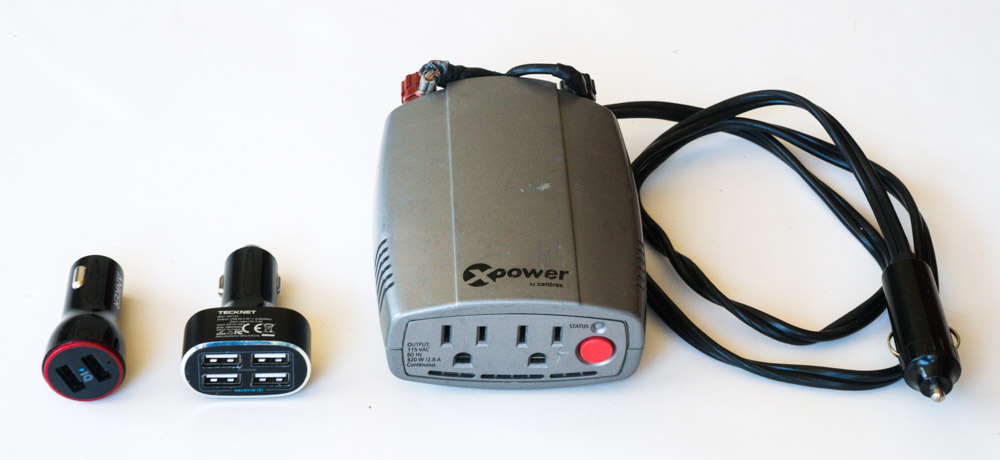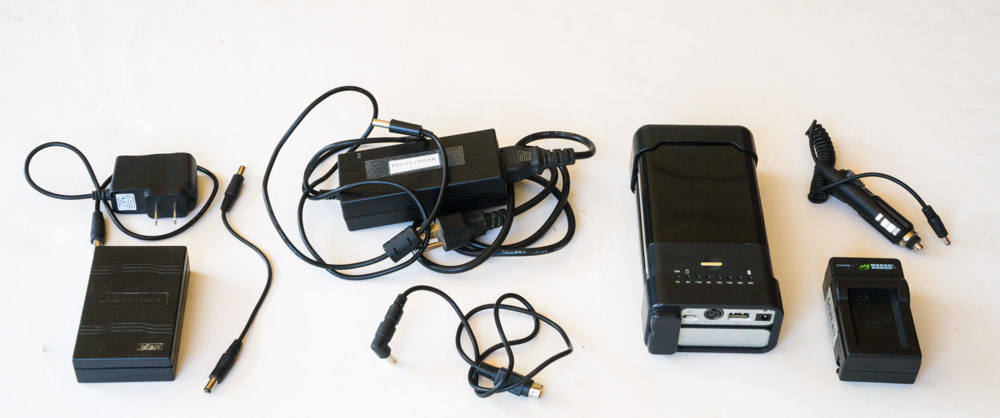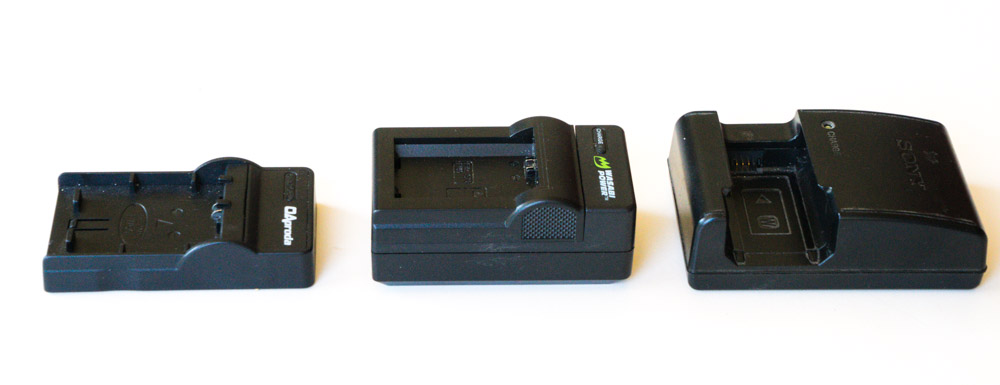How to Charge Digital Cameras in the Field
7 Comments
Modern digital cameras can go through batteries quickly. One can just carry enough camera batteries to last for an entire short trip – I own more than a dozen. If you stay under a roof at least every other night, plugging into AC power to recharge your batteries is easy. Otherwise, another way to charge those batteries is needed. In this article, after surveying all available options, I detail the solution I settled on after trying many, down to brand and models.

In 2016, I flew in by floatplane and spent five days at Brooks Camp in Katmai National Park in Alaska. Without access to AC power nor a car, I relied exclusively on external batteries to recharge camera batteries for my two power-hungry mirorless Sony A7R2s.
Charging from the car
On a trip where you drive abundantly each day, you can charge camera batteries using the car 12V DC power from the cigarette lighter. The manufacturer-supplied camera battery charger often operates only on 110V AC, and you could use a power inverter to obtain 110V power from the car’s 12V. Besides the fact that you are converting 12V to 110V and then back to a lower voltage in the camera battery charger, those devices can heat up quite a bit and are not the safest to use. The alternative is to buy a third-party camera battery charger that operates from a lower voltage, either 12V or a 5V (USB). I’ve used both and have a strong preference for USB as discussed later. If I need to recharge camera batteries quickly, unless I am driving non-stop, I will plug them to an external battery rather than to the car’s 12V outlet. This allows camera batteries to recharge even during stops. At the same time, I recharge other external batteries that are not in use on the car’s 12V outlet.

Left to right: dual and quad cigarette lighter to USB adapters, power inverter.
Charging while camping
Private campgrounds often provide AC power. In general, public (including National Park Service) campgrounds do not provide AC power at regular campsites. It is found in the bathrooms, where the plugs are meant for shaving, not recharging devices. Charging batteries from your parked car runs the real risk of depleting your car’s battery and leaving you stranded. Mitigating this risk by leaving the engine running consumes gas and can be a nuisance. Solar could work if you have a campsite set during the day, but is not dependable since efficiency depends on weather conditions. With no access to AC power, the best way to recharge your camera batteries is from external batteries. Depending on the trip I carry anywhere between two to half a dozen 10,000mAh 5V batteries.

The Kendesnii Campground in Wrangell-St Elias National Park, Alaska, where we stayed for three nights, has great views, but no electricity.
Multiple-purpose batteries v. Single-purpose batteries
I always leave in the car a Bestek battery primarily advertised as a jump-starter that works extremely well for that purpose. It is also advertised as a power source. However, although according the manufacturer’s stated capacity it should be able to charge at least 6 Sony batteries, it barely charges 2. The discrepancy is even worse with a Tekkeon battery that can deliver almost any voltage from USB to the 19V needed by laptop computers. I used to carry that one in all my travels for its versatility, before discovering how inefficient it is for charging. If a battery has to support a variety of loads ranging from jump starting cars to charging cellphones or cameras, it is difficult to design a high efficiency power converter across such a wide range and to find the perfect battery technology to perform well in every case. For example, to jump start a car, you need to deliver huge amount of current (in the order of a few hundred Amps) for a short time. To charge a camera battery, you need to delivery mA for hours, at the opposite end of the application spectrum from jump starting a car. The bottom line is that the most efficient batteries are those that deliver a single voltage and are meant for a single type of use (charging other batteries) and nothing else.12V v 5V (USB)
Which voltage to choose? The fact that it is easier to convert voltage down than up favors the batteries and chargers that use the lowest voltage that is common, which is the 5V of USB-powered devices. Not only they are more efficient in use, but also having the same input and output current makes things simpler to manage. The three 12V external batteries that I own need to be charged by plugging into AC power, whereas all USB external batteries can be charged from AC, 12V, or USB. USB ports are ubiquitous, being found in computers, recent cars, and solar panels. With the proliferation of mobile devices that are all USB-charged, external USB batteries are much more common than 12V external batteries, and available in a variety of shapes and sizes to fit any situation. In addition, most modern cameras can charge their battery if you plug a USB cord, so you always have a USB camera battery charger with you. The only reason to use 12V external batteries would be if you have devices that are 12V-powdered, which is a standard in the video world, and is also used by some motion-control apparatus.

12V power kit. Left to right: Dynamic Perception 12V battery (2700mAh, 194g), Tekkeon battery with extender (7200mAh, 810g), Wasabi Power Sony NP-FW50 charger.
Choosing USB external batteries
I have now standardized on 5V power. As illustrated by the example above, battery manufacturer specifications are not to be trusted. The only way to find one that works reliably is to test. A meter helps by displaying the total energy delivered. After testing several brands and models, I have settled on the 10,000 mAh Anker external batteries. I’ve been told that they use cells from Panasonic which makes some of the highest quality Li-ion batteries in the industry. They deliver about 90% of the specs (some others have been as low as 25%, and even Anker’s 13,000 mAh battery whose dual USB ports are useful, wasn’t as efficient), have some of the best capacity to weight ratio of any external batteries, and are cost-effective. If you need a more rugged battery the Goal Zero devices (such as this one) have very nice features but are quite more expensive.Charging camera batteries from USB external batteries
You’ll have to buy a third-party USB camera battery charger. I use the OAproda NP-FW50 for Sony which costs less than $10, and equivalent products are available for other camera brands. They are so much more versatile, since you can use them with AC, 12V, and USB, and a side benefit is that they are smaller and lighter than the manufacturer-supplied AC camera battery charger. By the way, the same is true of other devices as well, for instance USB-powered headlamp, lanterns, and AA/AAA chargers, and now I favor those that can be recharged by USB over those that require AC. You’d think that a USB cable is a USB cable, but their choice matters, the shorter and thicker the better, and not only for bulk reduction. With a long and thin USB cable, you could lose as much as 40% of the power. There are also several dual camera battery chargers available, which are slightly more compact than two single camera battery chargers and more convenient as they require only one USB connection instead of two. However, carrying two single camera battery chargers provide more redundancy, should one of the devices fail.

Sony NP-FW50 chargers. Left to right: OAproda (USB, 30g), Wasabi Power (12V, 70g), Sony OEM (AC, 85g).
Recharging USB external batteries
To charge USB batteries (external or camera) from AC power, you need a AC-USB adapter. Although all of them could work in a pinch, their performance varies as much as the external batteries performance. I’ve found the Anker 6-port charger to work very well, maybe because the manufacturer could optimize it operate with their own batteries. To charge USB batteries from 12V DC, one quad cigarette lighter to USB adapter is normally enough for me, and it is not much bigger than one with a single outlet. Here is the power kit with which I normally travel:

5V/USB power kit. Left to right: OAproda Sony NP-FW50 chargers, quad cigarette lighter to USB adapter and iPhone cable, Anker 6-Port USB Wall Charger with replacement short power cable, USB cables, Anker 10,000mAh and 13,000mAh 5V batteries.


Thank you! I wasn’t aware that third-party USB camera chargers existed. I definitely need a couple.
What’s your bottom line, Tuan. Is all this more, less or the same amount of hassle that traveling with 5×7 reversal film and film holders was? 🙂
We haven’t even talked about digital backup, but still, no contest, film was worse, because of the necessity to load and unload holders, especially when keeping track of the backup identical shots so that their processing could be tweaked after the corresponding primary transparency was reviewed.
I’m also a big fan of Anker’s line. They consistently get good reviews on Wirecutter and the like. Cool post QT.
Are you concerned at all that third party usb chargers will damage or not charge your camera batteries properly? I worry that there is some secret sauce in use with first party chargers and that third party chargers will mess up my batteries… have you found any issues?
With Sony my batteries are also third-party (because you need so many of them), but before I used for many years a third-party charger with original Canon batteries and haven’t noticed any problem.
Slightly off topic…
I want to bypass the battery in my Casio EX-FH100 (which uses a li-ion battery) with a 5V AC adapter, but not sure if it’ll risk frying the camera. Otherwise maybe use a series diode to drop the voltage? or a Zener around 4V?
I tend to think that digicams designed for li-ion batteries can handle 5V instead of just 4.2, especially since they’re typically USB-enabled and USB is based on 5VDC.
I’ve inquired to Casio, not sure I’ll get an answer. Anyone else done this?